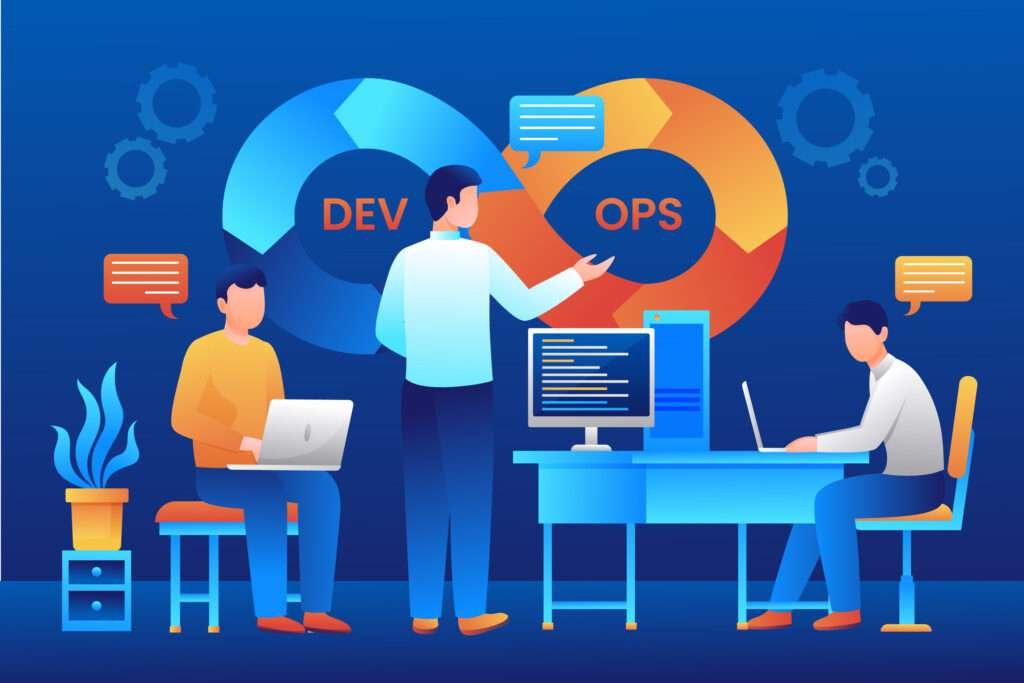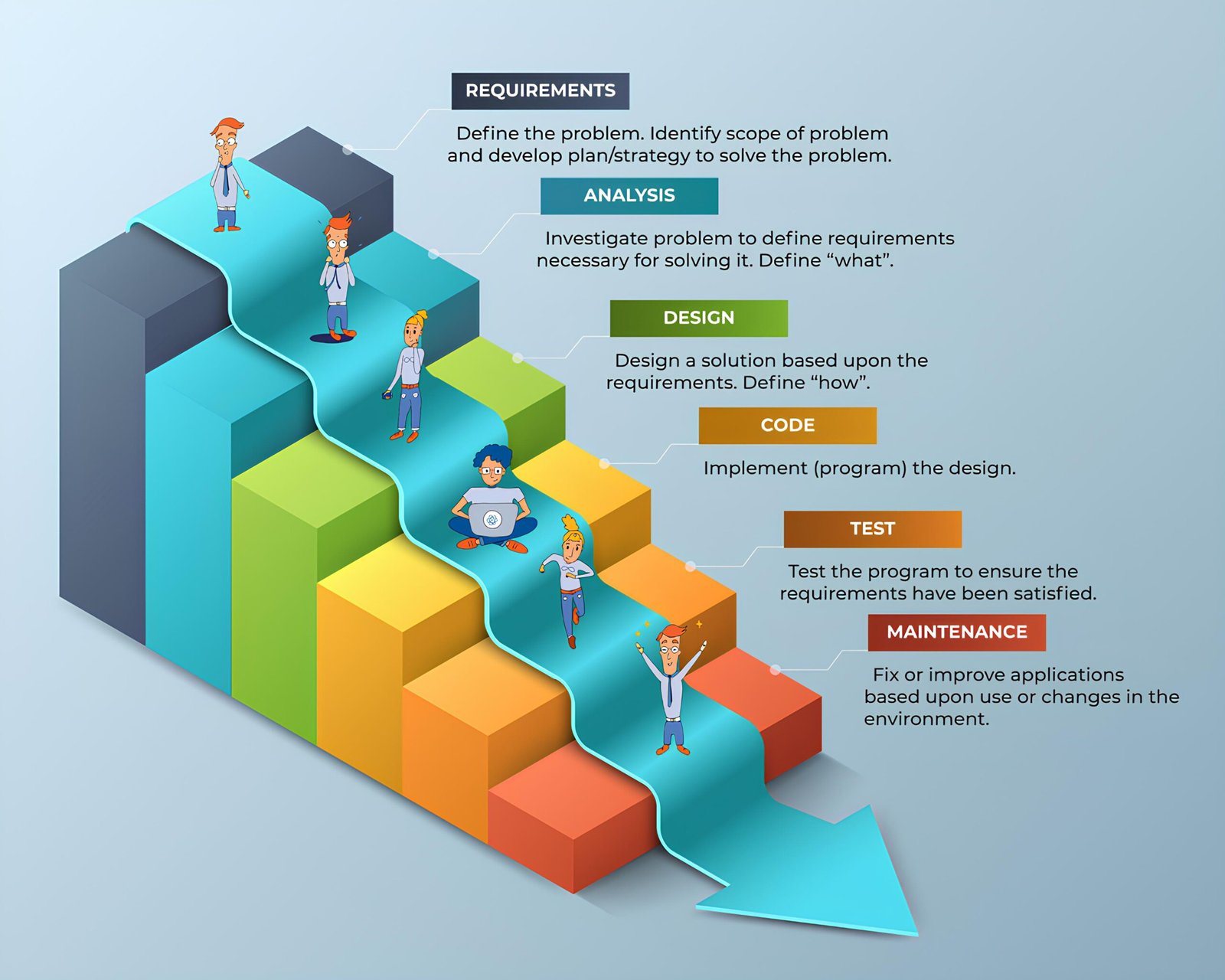What is Software Development Methodologies?
As a software developer, I deeply appreciate the significance of employing a robust and efficient development process. Implementing the right methodology is crucial not only to the success of a software project but also enhances team collaboration and ensures the on-time delivery of quality software products. In this comprehensive guide, I will explore a variety of software development methodologies that are pivotal in shaping a project’s strategy.
You’ll be introduced to traditional methodologies such as the Waterfall model, which is renowned for its structured and sequential approach, and the V-model, which emphasizes verification and validation at each stage of the development process. These methodologies are ideal for projects requiring high levels of precision and predictability. We’ll also take a look at how these frameworks have been foundational in the evolution of software development practices, setting the stage for more modern methodologies that address rapidly changing requirements.
Software development methodologies contrast, agile frameworks such as Scrum, Kanban, and Extreme Programming (XP) offer more flexibility and are better suited for projects that need to adapt to evolving requirements. These methodologies encourage iterative development, continuous feedback, and a high degree of collaboration among team members. By understanding the strengths and weaknesses of each methodology, and considering factors such as project objectives, team size, industry requirements, and time constraints, you will be better equipped to choose the one that aligns best with your project’s goals and requirements. This guide will provide you with the insights needed to navigate these choices, helping you to streamline your development process and enhance project outcomes.
Waterfall Methodology
The Waterfall methodology is one of the oldest and most traditional software development methodologies. It follows a linear approach, where each phase of the development process is completed before moving on to the next one. This methodology is characterized by its strict planning and documentation requirements. It is most appropriate for projects that have clear and stable requirements.
A primary benefit of the Waterfall methodology is its predictability. Since each phase is completed before moving on to the next one, it allows for better estimation of project timelines and costs. However, one of its main disadvantages is its lack of flexibility. Once a phase is finished, making changes is challenging without returning to the start. This can be a problem when requirements change or new information emerges during the development process.
Agile Methodology
Agile methodology is a highly flexible and iterative approach to software development methodologies. It focuses on collaboration, adaptability, and the delivery of working software in short iterations. The Agile methodology is based on the Agile Manifesto, which emphasizes individuals and interactions over processes and tools, working software over comprehensive documentation, customer collaboration over contract negotiation, and responding to change over following a plan.
One of the key advantages of the Agile methodology is its ability to adapt to changing requirements. It allows for frequent feedback and collaboration with stakeholders, which helps ensure that the final product meets their expectations. However, one of the challenges of Agile is its lack of predictability. Since requirements can change throughout the development process, it can be difficult to estimate project timelines and costs accurately.
Scrum Methodology
Scrum is one of the most popular frameworks for implementing Agile methodology. It is a lightweight and iterative approach that focuses on delivering value to the customer in short increments called sprints. The Scrum methodology emphasizes self-organizing teams and regular communication through daily stand-up meetings, sprint planning, sprint reviews, and retrospectives.
One of the key advantages of the Scrum methodology is its ability to deliver working software quickly and frequently. By breaking down the development process into small, manageable sprints, it allows for continuous feedback and improvement. However, one of the challenges of Scrum is its reliance on effective collaboration and communication among team members. Without proper coordination, the development process can become chaotic and unproductive.
Kanban Methodology
Kanban is a visual project management tool that originated from Lean manufacturing principles. It focuses on visualizing the workflow, limiting work in progress, and continuously improving the development process. The Kanban methodology uses a Kanban board, which is divided into columns representing different stages of the development process. Each task is depicted by a card that transitions across the board as it advances.
One of the key advantages of the Kanban methodology is its ability to optimize workflow and identify bottlenecks in the development process. By visualizing the work and limiting work in progress, it helps teams identify and resolve issues more efficiently. However, one of the challenges of Kanban is its lack of structure and defined roles. Without proper guidelines, teams may struggle with prioritization and coordination.
Lean Methodology
Lean methodology is a systematic approach to minimizing waste and maximizing value in the development process. It focuses on eliminating non-value-added activities, reducing lead times, and continuously improving efficiency. The Lean methodology is based on the principles of Lean manufacturing, such as just-in-time production, continuous flow, and pull-based systems. One of the key advantages of the Lean methodology is its emphasis on efficiency and waste reduction.
By eliminating non-value-added activities, it helps teams streamline the development process and deliver value to the customer more quickly. However, one of the challenges of Lean is its reliance on data and metrics. Without proper measurement and analysis, it can be difficult to identify areas for improvement and track progress accurately.
DevOps Methodology
DevOps is a combination of development and operations practices that aims to improve collaboration and streamline the software development process. It emphasizes automation, continuous integration, and continuous delivery. The DevOps software development methodologies emphasizes communication and collaboration between developers, testers, and operations teams to ensure a smooth and efficient delivery process.
One of the key advantages of the DevOps methodology is its ability to improve the speed and quality of software delivery. By automating repetitive tasks and integrating development and operations processes, it helps teams deliver software more quickly and reliably. However, one of the challenges of DevOps is its cultural and organizational impact. It requires a shift in mindset and collaboration across different teams, which can be difficult to achieve in traditional organizational structures.
Choosing the Right Software Development Methodology for Your Project
When choosing a software development methodology for your project, it is important to consider your project’s goals, requirements, and constraints. Each methodology has its own strengths and weaknesses, and the best choice depends on the specific needs of your project.
One approach is to evaluate the stability of your project’s requirements. If the requirements are well-defined and unlikely to change, a traditional methodology like Waterfall may be a suitable choice. On the other hand, if the requirements are likely to change or evolve, an Agile methodology like Scrum or Kanban may be more appropriate.
Another factor to consider is the level of collaboration and communication required. If your project involves multiple stakeholders and requires frequent feedback and collaboration, an Agile methodology like Scrum or DevOps may be a better fit.
However, if your project requires more structure and predictability, a traditional software development methodologies like Waterfall or Lean may be a better choice. Ultimately, the choice of methodology depends on the unique needs of your project. It is important to evaluate the pros and cons of each methodology and choose the one that aligns best with your project’s goals and requirements.
Benefits and Challenges of Different Software Development Methodologies

Each software development methodologies has its own set of benefits and challenges. Understanding these can help you make an informed decision when choosing the right methodology for your project.
The Waterfall software development methodologies offers predictability and a clear project timeline. However, it lacks flexibility and can be difficult to adapt to changing requirements.
Agile software development methodologies, including Scrum and Kanban, provide flexibility and adaptability. They allow for frequent feedback and collaboration, which can lead to a better final product. However, they can be challenging to estimate and can result in a lack of predictability.
The Lean software development methodologies emphasizes efficiency and the reduction of waste. It helps teams streamline the development process and deliver value more quickly. However, it relies heavily on data and metrics, which can be challenging to implement.
DevOps software development methodologies improves collaboration and streamlines the development process. It enables teams to deliver software more quickly and reliably. However, it requires a cultural shift and collaboration across different teams, which can be difficult to achieve.
Best Practices for Implementing Software Development Methodologies
Applying a software development methodology involves thorough planning and careful execution. Here are some key best practices to keep in mind:
1. Define clear goals and objectives: Clearly define the goals and objectives of your project. This will help you choose the right methodology and set expectations for your team.
2. Involve stakeholders: Involve stakeholders from the beginning of the project to ensure their needs and expectations are considered. This will help you choose a methodology that aligns with their requirements.
3. Train your team: Provide training and resources to your team to ensure they understand the chosen methodology and can effectively implement it.
4. Start small and iterate: Start with a small pilot project to test the chosen methodology and make adjustments as needed. This will help you identify any challenges or issues early on and refine your approach.
5. Regularly review and improve: Continuously review and improve your development process. Solicit feedback from your team and stakeholders and make adjustments as needed.
By following these best practices, you can increase the chances of success when implementing a software development methodologies.
Case Studies of Successful Software Development Projects Using Different Methodologies
To further illustrate the benefits of different software development methodologies, let’s take a look at some real-life case studies:
1. Waterfall Case Study: Company XYZ successfully implemented the Waterfall methodology for a large-scale software development project. By carefully planning and documenting each phase, they were able to deliver the project on time and within budget. However, they faced challenges when requirements changed midway through the project, resulting in delays and additional costs.
2. Agile Case Study: Company ABC adopted the Agile software development methodologies, specifically Scrum, for an e-commerce website development project. By involving stakeholders in the development process and delivering working software in short iterations, they were able to quickly adapt to changing requirements and deliver a high-quality product. However, they faced challenges with estimating project timelines and costs accurately due to the iterative nature of Agile.
3. Kanban Case Study: Company DEF used the Kanban methodology for a software maintenance project. By visualizing the workflow and limiting work in progress, they were able to identify bottlenecks and resolve issues more efficiently. However, they faced challenges with prioritization and coordination, as the lack of structure in Kanban made it difficult to manage the workload effectively.
These case studies highlight the benefits and challenges of different software development methodologies in real-world scenarios. By learning from these experiences, you can make more informed decisions when choosing the right methodology for your own projects.
Conclusion
Choosing the right software development methodologies is crucial for the success of your projects. Each methodology has its own strengths and weaknesses, and the best choice depends on your project’s goals, requirements, and constraints. Whether you opt for the predictability of the Waterfall methodology, the flexibility of Agile methodologies like Scrum or Kanban, the efficiency of Lean, or the collaboration of DevOps, it is important to carefully evaluate your options and choose the software development methodologies that aligns best with your project’s needs. By following best practices and learning from real-life case studies, you can implement your chosen methodology successfully and achieve efficient development processes.
Subscribe to our newsletter to receive future updates on Technology, Artificial Intelligence (AI), and Tech Trends. Explore our categories to find more relevant stuff. Stay informed and motivated with our most recent insights!




